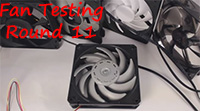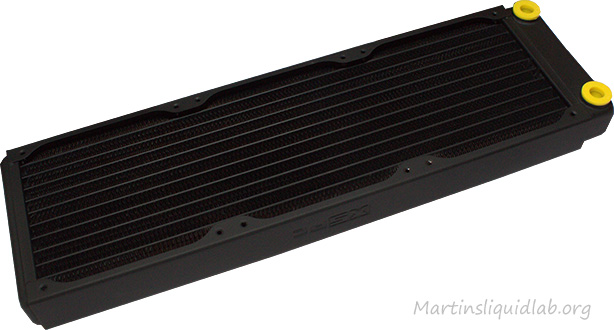Radiator-Sandwiches / Stacked RadiatorsIt’s a while back that I posted some rudimentary test results on stacked rads in
this thread.I still have the two magicool triple-rads from that test but now, I also have heaters (300W) which allow for much better testing. So I gave this whole sandwich-thing another go.All of the tests were done with said Magicool Slim rads, Nanoxia FX-1250, a 300W heater and a MCP355. All of the numbers are indications of the temperature difference between water- and ambient-temperatures achieved after 35 minutes of heating the water.Here are the different scenarios tested:
Solo Rad with 3 fans
 Solo Rad with 6 fans
Solo Rad with 6 fans

2 Rads separate with 6 fans (3 each)

Sandwich with 3 fans

Here, the water flows to the rear rad first. This way, the airflow goes from the cooler to the warmer radiator.
Sandwich with 3 fans – Version 2

Here the water goes to the front rad first, so the airflow goes from the warmer to the cooler radiator. It’s clear that this is less optimal than the option above but I wanted to test how much of a difference it makes.
Sandwich with 6 fans

Sandwich with 6 fans – Version 2

This is, again, the less optimal flow with the airflow going from warmer to cooler rad.
Rad-Rad-Fan Sandwich

Here, I only tested the optimal flow-version (airflow from cooler to warmer rad).
I also tested with the radiators in parallel flow, but I lost some of the data and got the rest mixed up, so I’ll have to redo those tests.
Results 1

CLICK TO ENLARGE
The first, shocking realization is this: The stacked rads almost always perform worse than the solo rad with the same number of fans. The rest of the data is as expected: Two separate rads perform best, more fans are always better and the airflow going from warmer to cooler rad is slightly worse than the other way around.
I couldn’t believe that the sandwiches performed worse than the solo rad, initially. I retested everything and got identical results, though.
So, I thought it might be a question of air-pressure. The fans need to build more pressure to move the same amount of air through two radiators than one. This would lower performance.
To test this hypothesis, I set up the loop with the solo radiator again. This time, I installed the second radiator as well, just as in a stacked setup, but didn’t add the extra radiator to the loop. This way, the second rad acted as an “Airbreak” in front of the fans and I could see how much of an effect this would have on temperatures.
Results 2 – Airbreak

The results affirm my theory in two ways:
1. We see that the “airbreak”-rad has a huge impact on temperatures (much more than I would have guessed).
2. We see that the performance loss is smaller with higher rpm. At 800rpm the loss is 49%, at 1200rpm it shrinks to 23%.
There should be a tipping point where the fan produces more than enough pressure and the stacked rads start outperforming a solo radiator.
Unfortunately, the only high-rpm fans I have here are Yate Loons and since they have closed corners, I can’t do a stacked rad setup with these fans.
But I have some Yates here that are 38mm thick and have open corners. The thicker fans should produce more pressure and might be able to overcome the extra resistance in a stacked setup sufficiently.
Results 3 – 38-mm-fans

The thick Yates unfortunately don’t go higher than 1250rpm either, so I couldn’t test higher rpm. Though from the results it’s clear that there is an advantage to the thicker fans. Now, at 1200rpm, the stacked rad’s performance catches up with that of the solo rad.
Too bad it wasn’t enough for the stacked setup to get ahead, but I already have something else planned.
The thing is, the Magicool rads seem to simply have too high an FPI count to be useful for stacking. At least at the kinds of fan speeds that my ears tell me are reasonable.
So I ordered a second Magicool Slim Elegant rad. This rad has much lower FPI count and did exceedingly well at low rpm. This should make it an ideal candidate for rad-sandwiching. 
So, while I once again have to leave you with an “I will do more testing on this later”, I think I have come to a useful conclusion here: When stacking rads, the fan pressure requirements increase greatly. Low FPI-rads as well as high-pressure fans should be preffered for such setups.
Hope you liked this report.
Cheers,
Shane




















 .
.
You must be logged in to post a comment.